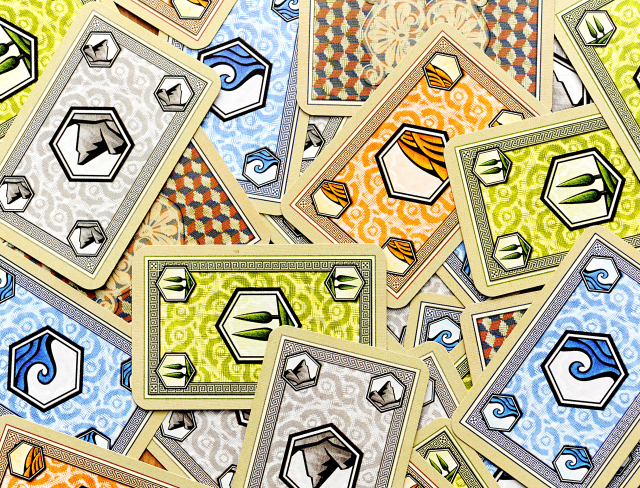Attika was published in 2003 and designed by Marcel-André Casasola Merkle. It’s one of those games that not too many people have heard of, but once they give it a shot they love it!
Attika uses a modular board to create a fictional Greek landscape. It plays between 2-4 players and usually lasts less than an hour. The goal of the game is to use the resources already spread throughout the land and the resource cards in your hand to layout building and city tiles from your player mat on to the board. The winner will be the person able to connect two temples with an unbroken path of your own tiles or the first person to get all 30 of their tiles on to the board.
The tiles are divided into main buildings and normal buildings. At the start of the game players make three equal piles of normal building tiles facedown and one pile of the main buildings. Each player will take the top tile from each pile and place it on their personal player board in its specific spot. This gives each player a bit of a starting hand. The personal player boards show you every tile in the game and also their relationship to each other. Each main building has a family of normal building related to it. For example the Quarry, Fortress and Towers make up the Defense family. Building tiles adjacent to the main building in a group makes them free. So, if I can build a Harbour, then every Ship I build is free as long as it’s touching the Harbour. Linking together chains can greatly reduce the cost in resources for your buildings. Not only that, each time you complete a full family of buildings you get an amphora. They can be cashed in for extra actions.
One of the appealing elements of Attika is that it has very simple rules. Each turn you will either draw new tiles, build buildings from your player board or give up some actions to draw resource cards. When you build tiles from your player mat you have the option to build up to three. When drawing new building tiles you only get two draws, but if you can build those tiles they can go directly onto the board.

This fictional Greek landscape starts off very small. There’s not a lot of room and paths between the temples can quickly be cutoff. Not to worry. Each time you draw the last tile from a pile you can to add a new landscape piece to the board. This can create a new route to connect temples or just give you a pocket of land that is most easily accessed by your tiles.
Attika is best played with two. With three someone always has to play spoiler and it’s a bit too chaotic with four. Attika with two is an excellent chess match to see who can block who and which player will jump ahead with a big move and connect the temples. If a game switches to be about getting all your tiles on the board rather than making the temple connection then it becomes a real race. Which tiles you pick up and when can make a huge difference in the end game.
The components and art are minimal in Attika. Each player has their own mat representing one of the great societies of ancient Greece, Sparta, Corinth, Athens and Thebes, as well as 30 tiles in their respective colour. The building tiles are small, but each one has some pretty neat art. Resources are gained from mountains, trees, water and fields, and you find them on both cards and the board itself. Speaking of the board that’s probably the most interesting component. Each modular piece is shaped like a cog. The fit together snugly and although there is a starting set up to each game, the board will grow and vary wildly as play progresses.
With the different board set up every game and the randomness of the tile distribution, each game of Attika feels like a fresh challenge. I’ve heard it called a ‘brown’ game in the past, meaning a dry, Euro-style fare, but give it a chance and I think you’ll really like this simple masterpiece.
As you said: not many knows it, but the few loves it!
It is maybe a bit Euro-dry, but it is one of the most thrilling games I played. I would say in these 40 games I played, only 3 of them were bored in the end…
[…] Attika combines board control and resource management and while you can play this game with up to four, I highly recommend against it. Too many players makes this game dissolve into chaos. The streamlined two player experience makes for one of my favourite games of all time. You can see a full review here. […]
[…] it was designed by Marcel-André Casasola Merkle (creator of another one of my favourites, Attika) with art by the amazing illustrator and designer Michael Menzel (you’ve likely seen his art in […]